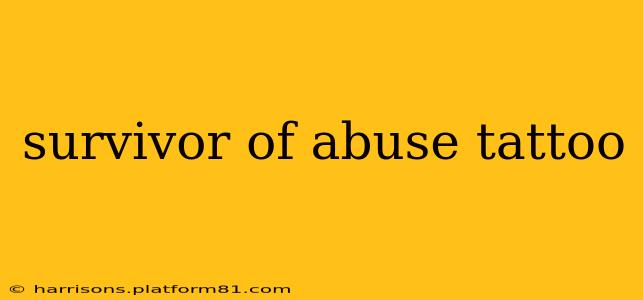For many survivors of abuse, a tattoo can be a powerful symbol of resilience, healing, and reclaiming their narrative. It's a deeply personal journey, and the choice to get a tattoo is entirely individual. This post explores the reasons why survivors choose this form of self-expression, the types of designs they often select, and the importance of finding a supportive and understanding artist.
Why Do Survivors Get Abuse Survivor Tattoos?
The reasons behind choosing a tattoo as a form of healing are varied and deeply personal. For some, it's a tangible representation of overcoming trauma and emerging stronger. It serves as a constant reminder of their strength and journey, a silent testament to their resilience in the face of unimaginable hardship. Others find that the process of designing and getting a tattoo is itself therapeutic, providing a sense of agency and control over their bodies, something often taken away during abuse. The act of permanently marking their skin can feel empowering and liberating.
What are Common Tattoo Designs for Abuse Survivors?
There's no single "right" design for an abuse survivor tattoo. The imagery chosen is deeply personal and often reflects the individual's specific journey and healing process. However, some common themes emerge:
- Phoenix: This mythical bird rising from the ashes is a powerful symbol of rebirth, renewal, and overcoming adversity. It perfectly encapsulates the journey of healing from abuse.
- Semicolon: This simple yet profound symbol represents the continuation of life, a powerful message for those who have contemplated suicide or self-harm. It’s become a widely recognized symbol of hope and resilience within the survivor community.
- Flowers: Flowers, especially those known for their strength or resilience (like sunflowers or lotus flowers), symbolize beauty, growth, and the ability to flourish even after trauma.
- Geometric Designs: Clean lines and abstract shapes can represent order and control, a stark contrast to the chaos of abuse.
- Mandala: These intricate designs often represent balance, harmony, and inner peace, all vital elements in the healing process.
- Personal Symbols: Some survivors opt for designs that hold a specific personal significance, representing a memory, a significant date, or a symbol of hope.
What kind of tattoo designs represent healing and hope?
Many designs represent healing and hope, reflecting the positive aspects of recovery. Floral designs, for instance, represent growth and beauty, while birds in flight symbolize freedom and escape. Geometric patterns can represent order and structure, the opposite of the chaos often associated with abuse. The specific imagery is entirely up to the individual and what resonates most strongly with their personal experience.
What are some meaningful phrases or words for an abuse survivor tattoo?
The choice of words is extremely personal. Some survivors choose powerful words like "survivor," "stronger," or "resilient." Others might opt for a phrase that holds special meaning for them, a mantra, a lyric, or a quote that inspires them. The key is to choose words that resonate deeply and serve as a constant source of strength and inspiration.
Where is a good place to get an abuse survivor tattoo?
The placement of the tattoo is also a personal choice. Some survivors prefer a location that is visible, serving as a reminder of their strength and a source of empowerment. Others opt for a more discreet location, keeping the tattoo private. Regardless of placement, the most crucial factor is finding a reputable and trustworthy tattoo artist.
How can I find a supportive and understanding tattoo artist?
Finding a compassionate and understanding artist is crucial. Look for artists with experience working with trauma survivors, or who have a demonstrated commitment to creating a safe and supportive environment. Read reviews, look at their portfolio, and, most importantly, schedule a consultation to discuss your ideas and ensure you feel comfortable with the artist.
The Importance of Self-Care and Support
Getting a tattoo is only one aspect of the healing journey. It's essential to seek professional support, either through therapy or support groups. Remember that healing takes time, and there are resources available to help you along the way. You are not alone.
This article aims to provide information and support. It’s crucial to remember that every survivor’s experience is unique. This information should not be considered a substitute for professional guidance. If you are a survivor of abuse, please seek out professional help.
Disclaimer: I am an AI and cannot provide medical or therapeutic advice. The information provided here is for informational purposes only.
